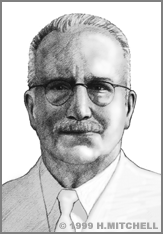Buckminster Fuller
Richard Buckminster Fuller, New England transcendentalist and futurist inventor, sought to harmonize technology with nature. His most famous attempt is the geodesic dome.
Born in New England in 1895, Fuller grew up a feisty child in a blue-blooded household. He entered Harvard as a legacy, but was expelled twice (the first time for consorting with a dance troupe). He then turned to the military. Fuller's family connections gained him a Navy command (1917), but his innovative nature led him to invent a winch system for rescuing drowning pilots. This invention won him an appointment at the Naval Academy in Annapolis (1918). Here Fuller began to develop his "Great Pirates" view of history.
After the death of his daughter in 1922, Fuller resigned from the Navy and spent some years depressed and out of work. He resolved this personal crisis by "committing egocide," that is, by transforming his life into an experiment for the benefit of humanity. He started calling himself "Guinea Pig B" ("B" for "Bucky").
However unscientific this might sound, Fuller's experiment soon brought real results. Long before there was a coherent ecology movement, he saw that the earth's resources were alarmingly finite. His first invention to counter this problem was the Dymaxion House (1927), whose metal frame and glass walls were suspended from a central mast. The prefabricated, material- and energy-efficient house was centrally air-conditioned and self-vacuuming (anticipating Frances Gabe by fifty years). It could be airlifted intact to almost any location.
Fuller followed this up with the Dymaxion Car, first demonstrated at the Chicago World's Fair in 1933. The car was a masterpiece of efficiency and economy; it was twenty feet long and held eleven passengers, but was as light as a VW Beetle, had only three wheels, and got thirty miles to the gallon. Fuller's car might have revolutionized the auto industry, but a much publicized crash – not the fault of the car – ruined its reputation.
Fuller responded to the post-World War II housing shortage by designing inexpensive "modern igloos" (1945). This idea did not catch on either, but it led to Fuller's best known invention. While a Professor of Architecture at Black Mountain College, Fuller created his geodesic dome (1948). Others had designed similar structures in the past, but Fuller's, based on his own patented ideas, was the first widespread success. The dome's octagonal truss framework lets minimal materials give maximum stability. Fuller's domes, which weigh a fraction of what modest houses weigh, are in fact impervious to natural disasters. And like the Dymaxion House, Fuller's ready-made geodesic domes could be delivered by helicopter.
After the geodesic dome was chosen as the United States Pavilion at Expo '67 in Montreal (where the 200-foot high edifice still stands), Fuller finally gained international attention. Thereafter, he was either a genius or a madman (or both), depending on whom one asked. "Synergetics" (1975) and the many other books Fuller published in the 1960s and 1970s intensified these perceptions, until and beyond Fuller's death in 1983.
Today, Buckminster Fuller's legacy lives on at the Buckminster Fuller Institute and in the studies and documentaries that now intrigue, and even inspire, a new generation.


